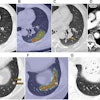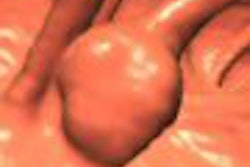SAN FRANCISCO - A CT scanner with with two x-ray tubes and two detector arrays jammed into the gantry promises big gains -- principally in terms of speed and power -- for imaging applications that have traditionally been starved for one or both.
Dual-source CT (DSCT) was a hot topic at presentations on Wednesday at the International Symposium on Multidetector-Row CT, sponsored by California's Stanford University. To date there has been limited clinical experience with the scanner, which was introduced at the 2005 RSNA meeting in Chicago and is currently produced by only one manufacturer, Siemens Medical Solutions of Malvern, PA. But similar devices are sure to be marketed by others if dual-source CT scannners continue to fulfill their potential -- and if they outpace other, competing CT scanner designs going forward.
DSCT's potential includes scanning so fast it can image racing hearts without beta-blockers, scanning plus-sized patients at higher resolution without extra radiation, and even separating different scannable elements such as calcium, iron, and iodine, and quantifying them.
According to the presenters, early testing has already yielded clear pictures of the vascular anatomy at the base of the brain -- for example, without a trace of artifact from the bony structures with which these vessels are are tightly interwoven. The unanswered question is whether the protocol is erasing calcium deposits in the blood vessels along with the unwanted bony structures.
The idea of dual-source CT isn't new, and significant brainpower was committed to the concept of dual-energy scanning in the 1970s and 1980s, said Willi Kalender, Ph.D., from the Insitute for Medical Physics at the University of Erlangen-Nürnberg in Germany. But the technology at the time was inadequate to the ideas being advanced, so the work was halted. Even today, development of the scanners presents a raft of technical issues, he said.
"If you want to go to faster scanning, you have to think of the mechanics," Kalender said. The Siemens Somatom Definition dual-source scanner has a maximum 0.33-sec rotation speed producing centrifugal forces on the order of 30 Gs, which is a difficult enough engineering challenge.
"But the real problem is, if you go faster and faster you need higher and higher x-ray power simply because the respective mAs product for a given image or slice has to be constant if you don't want to compromise image quality," he said. "If you increase the speed, you have to proportionally increase the power to arrive at the same image quality."
Today powerful x-ray sources of 6,100 kW are available, but it's not really feasible to double or triple their power, Kalender said. The electron beam CT concept was retired because its power could not be increased to continue increasing temporal resolution. But having two x-ray sources overcomes many of these limitations while remaining technically feasible, he said.
The Siemens system's two x-ray tubes and two detectors are mounted in a rotating gantry with an angular offset of 90°, the optimum angle to acquire 180º of coverage in the shortest time.
"What you have are two x-ray tubes, in this case the Stratton rotating vacuum vessel technology which allows for very small tubes yet very high power levels," Kalender said. "That certainly is a prerequisite to be able to accommodate two complete systems under the hood. One other prerequisite is that the second detector is reduced in size."
Owing to space limitations in the gantry, one detector covers the entire scan with a 50-cm field-of-view, while the other detector covers a smaller, central field-of-view of 26 cm. Each detector contains 40 detector rows 0.6-mm wide, and the four outer rows on both sides are 1.2-mm wide. Using a z-flying focal spot technique, the two 32-channel 0.6-mm measurements are combined to create 64 projections per rotation along the z-axis, with each 0.6-mm measurement overlapped by 0.3 mm, said Cynthia McCollough, Ph.D., from the Mayo Clinic College of Medicine in Rochester, MN, who discussed her extensive testing of the dual-source scanner in a separate talk.
"With respect to temporal resolution, you now have one-fourth of the rotation time (of a conventional scanner), and you have a guaranteed temporal resolution of 83 msec and it can be lowered to 42 msec with two-segment reconstruction," Kalender explained.
"In cases of obese patients, we don't have to compromise total scan speed," he said. "The x-ray power is available to accommodate them. With two tubes as expected the noise goes down.... That's good news, though some people will say ... if you double the x-ray power, you have double the dose. That would be the case if you scanned for a longer time, but of course it's the total mAs that's related to the patient dose, which is kept the same."
The dual-source scanner provides higher temporal resolution, Kalender said. Effective scan times are reduced by half, while x-ray power is doubled without the need for new technology.
Promising heart applications
In another talk, Dr. Christoph Becker from University Hospital at the University of Munich-Grosshadern in Germany discussed his group's experience with dual-source CT in heart imaging. Initial experiences with the scanner have shown that dual-source CT permits imaging of the coronary arteries without motion artifacts, even in patients with high heart rates.
An immediate advantage of ultrafast heart scanning is that a physician no longer needs to be present while the patient is being scanned, Becker said. With the 64-slice scanner, the administration of beta-blockers was necessary to slow the heart rate to 60 bpm or less for the acquisition of motion-free image data. Now there is only a nurse at the scanner, making sure the cardiac patient (loaded into the scanner feet-first with a pillow elevating the legs) is comfortable.
"We wanted to know how good was the dual-source CT even at higher heart rates, so we completely got away from the use of beta-blockers," Becker said. Now patients are prepared with two puffs of nitroglycerine under the tongue, he said, which may actually speed up heart rates but also expands the arteries for easier visualization.
Few side effects are associated with nitroglycerine use, save for an occasional headache, and one patient presenting with typical angina even asked to take a bottle home because it made him feel so good.
With nitroglycerine and high-flow concentrated contrast media, it's possible to visualize up to the third generation of coronary artery segments, Becker said. Still, reconstruction intervals must be tailored to the heart rate.
One patient was scanned with a heart rate of 76 bpm. Image reconstruction at 70% of the R-R interval eliminated motion artifact, although blooming artifact was seen surrounding a stent. The next patient came in with a heart rate of 80 bpm and multiple stents, but artifact was only a problem in the peripheral arteries. In a patient with a heart rate of 110 bpm, reconstruction had to be performed in systole at 30% of the R-R interval to eliminate motion artifacts, a common solution in patients with very high heart rates, Becker said. So far only one scan has been nondiagnostic, a result of image noise in an obese patient, according to Becker.
A 2-month-old infant with a congenital defect with a heart rate of 140 bpm was successfully imaged on the scanner. The left anterior descending (LAD) artery was attached to the pulmonary outflow tract instead of the aorta. A tunnel with a diameter of just 6 mm was introduced between the LAD artery and ascending aorta to attach the artery to the appropriate anatomic location, he said.
"Sometimes the function is the key to diagnosis," Becker said, showing images of a 52-year-old female patient who presented with acute coronary syndrome. Her coronary angiography was normal, but she was eventually diagnosed at dual-source CT with takotsubo cardiomyopathy.
Assessment of aortic and mitral valves is also significantly improved compared to previous scanner generations, with dual-source CT "now offering a clear depiction of the individual valve leaflets at most reconstruction intervals," Becker wrote in an accompanying abstract.
"Visualization of the aortic valve was not rated as diagnostic in early systole at 10% of the cardiac cycle, which would be desirable for planimetry," he wrote. Considering the added diagnostic value with left ventricular function and wall motion, valve assessment, and dynamic evaluation of the coronary arteries throughout the cardiac cycle, cardiac dual-source CT may represent a one-stop shop similar to MRI for cardiac assessment for some indications.
"The key advantage is that we now have cardiac function," Becker said.
In her talk, McCollough commented on the reasons for diminished motion artifact in dual-source CT of the heart.
"When you use dual-tube mode of operation, each tube collects 90° of the required 180°, so it's like a two-segment regment recontruction," she said. "But rather than taking that 90° of data over two different heartbeats, where potentially the heart does not contract in the exact same position and you get some motion blurring, it takes it from the same heartbeat."
By Eric Barnes
AuntMinnie.com staff writer
June 15, 2006
Related Reading
Cardiac imaging dazzles, but radiologists can't compete alone, April 10, 2006
Siemens launches new dual-source CT technology, November 17, 2005
Copyright © 2005 AuntMinnie.com




















